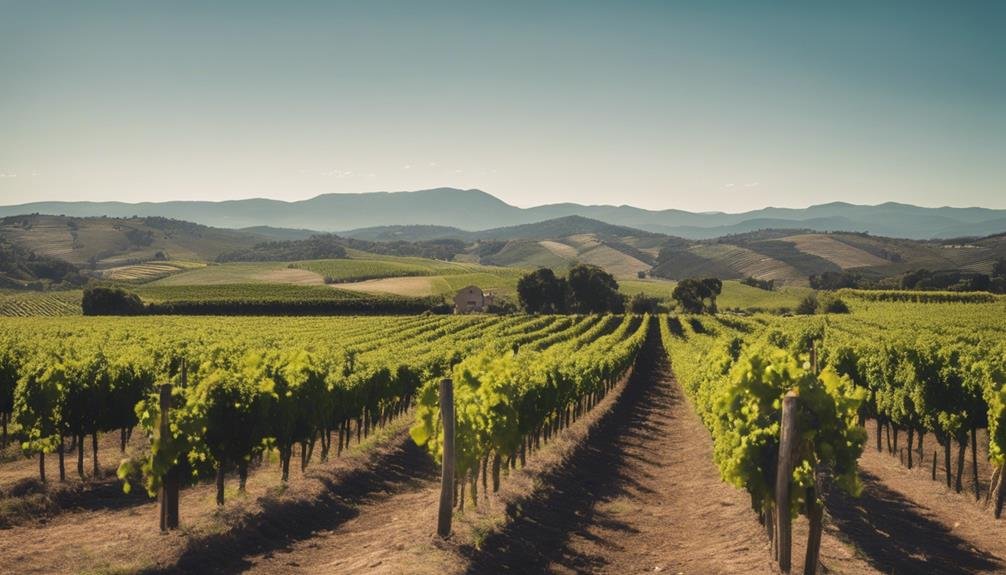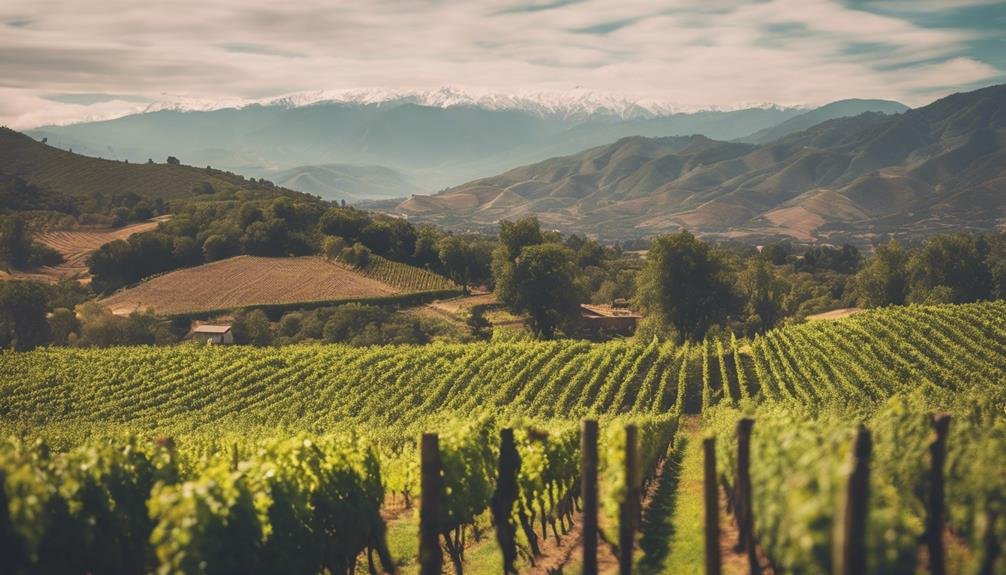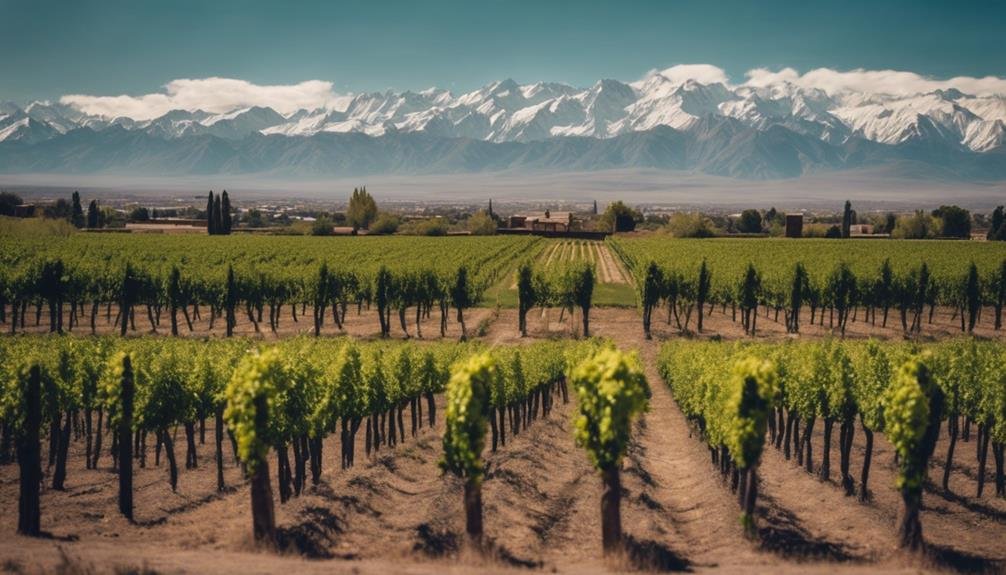South American wine regions offer a diverse landscape of flavors and traditions. Argentina boasts the renowned Mendoza region, celebrated for its Malbec. Chile showcases unique terroirs shaped by the Andes Mountains and Pacific Ocean, excelling in Cabernet Sauvignon and Carmenere. Uruguayan Tannat wines are known for bold flavors and high tannin levels, ideal for pairing with barbeque dishes. Brazil surprises with varietals like Chardonnay and Merlot, reflecting its terroirs with herbaceous notes. Emerging wine regions in South America promise innovation, gem discoveries, and quality standards. Discover the rich tapestry of South American wines and uncover a world of tantalizing flavors.
Argentinas Varied Wine Regions
Argentina's varied wine regions showcase a diverse array of terroirs that contribute to the country's reputation as a prominent wine-producing nation in South America. The Malbec dominance in regions like Mendoza has propelled Argentina to global recognition.
High altitude vineyards in the Andean foothills provide ideal conditions for grape cultivation, resulting in bold and robust wines. Torrontes expressions from Salta offer aromatic white wines with floral notes, unique to Argentina.
Additionally, newer regions like Patagonia have gained attention for producing exceptional Pinot Noir, adding diversity to Argentina's wine portfolio. The country's ability to cultivate a wide range of grape varieties in distinct terroirs has established it as a key player in the world of wine, attracting wine enthusiasts seeking quality and diversity.
Chilean Terroirs and Grape Varieties
In exploring South America's wine landscape, the focus now shifts to the diverse terroirs and grape varieties that define Chilean winemaking excellence.
Chilean terroir analysis reveals a unique combination of factors, including the Andes Mountains' influence on vineyard altitudes and the cooling effect of the Pacific Ocean. These elements contribute to the distinct characteristics found in Chilean wines, such as vibrant acidity and rich fruit flavors.
When it comes to grape variety comparison, Chile excels in producing exceptional Cabernet Sauvignon, known for its elegance and structure. Additionally, Carmenere, a grape variety championed by Chile, offers spicy notes and velvety textures, setting it apart in the world of red wines.
Chile's commitment to quality winemaking continues to elevate its reputation on the global stage.
Uruguayan Tannat Wines Unveiled

Uruguayan Tannat wines showcase distinctive characteristics that set them apart in the world of South American viticulture. Known for their high tannin levels, moderate-to-high alcohol content, and gritty texture, Uruguayan Tannat wines offer a unique tasting experience. While not widely exported, these wines are highly praised locally for their bold flavors and excellent aging potential. Uruguayan winemakers have mastered the art of working with the rigorous Tannat grape, producing exceptional bottles that pair perfectly with barbeque dishes. The table below highlights key points about Uruguayan Tannat wines:
| Aspect | Description |
|---|---|
| Flavor Profile | Bold, tannic, dark fruit flavors |
| Aging Potential | Excellent for long-term cellaring |
| Tannin Level | High |
| Food Pairing | Ideal with barbeque dishes |
Exploring Brazils Wine Diversity
Uruguay's Tannat wines showcase distinctive characteristics, while Brazil's wine industry is rapidly gaining recognition for its diverse offerings, particularly in regions like Serra Gaúcha. Brazilian terroirs play a vital role in shaping the unique varietals produced in the country.
Southern Brazil, with its ideal climate and soil conditions, is known for producing fine wines, especially Chardonnay and Merlot. Brazilian wines stand out for their herbaceous notes, resembling Italian wines more closely.
Intriguingly, Brazil's wine industry coexists harmoniously with coffee and chocolate production, adding to the country's rich agricultural tapestry. As Brazil continues to explore and develop its winemaking capabilities, it is establishing itself as an exciting player in the global wine market, offering a diverse range of flavors and styles.
Emerging Wine Regions in South America

The emerging wine regions of South America are capturing the attention of wine enthusiasts worldwide with their unique terroirs and exceptional varietals.
- New World Exploration: These regions offer a fresh perspective in the wine world, showcasing innovative approaches and distinctive flavors.
- Hidden Gems Discovery: Uncover lesser-known areas that hold immense potential, waiting to be explored and appreciated by discerning palates.
- Exciting Terroir Diversity: From coastal vineyards to high-altitude plantations, experience a range of terroirs that contribute to the complexity of South American wines.
- Varied Grape Varieties: Discover a plethora of grape varieties beyond the traditional, reflecting the region's rich viticultural heritage and experimentation.
- Rising Quality Standards: Witness the continuous evolution and improvement in winemaking practices, elevating these emerging regions to global recognition.
Frequently Asked Questions
What Is the Significance of Malbec in Argentinas Wine Industry?
Malbec's popularity in Argentina's wine industry is significant due to its unique terroir-driven grape characteristics. Its rich, full-bodied profile aligns with current wine trends, positioning Argentina as a leading producer of world-class Malbec wines that showcase distinctive regional flavors.
How Does Chilean Carmenere Differ From Other Red Varieties?
Carmenere, a distinctive Chilean red variety, offers a unique flavor profile with notes of dark fruit and green pepper. Known for its aging potential, it pairs well with hearty dishes. Thriving in Chile's diverse climates, Carmenere stands out among red wines.
Why Are Uruguayan Tannat Wines Not Widely Exported?
Uruguayan Tannat wines, akin to hidden gems in a vault, possess robust tannins and distinct flavors. Their limited exportation stems from a lack of global recognition, despite being ideal for local cuisine.
How Do Brazilian Wines Compare to Traditional Italian Wines?
Brazilian winemaking techniques showcase unique flavors, distinct from traditional Italian wines. While Italy is known for its Sangiovese and Nebbiolo, Brazil specializes in Chardonnay and Merlot, offering herbaceous notes that set them apart in the wine world.
What Challenges Do Emerging Wine Regions in South America Face?
Emerging wine regions in South America face challenges due to climate change and economic factors. With climate variability affecting grape ripening and economic fluctuations impacting production costs, these regions must adjust to guarantee sustainability and quality.
Conclusion
In the vast landscape of South American wine regions, a symphony of flavors and terroirs harmonize to create a diverse tapestry of exceptional wines. From Argentina's robust Malbecs to Chile's elegant Carmenere, each region offers a unique expression of the land and climate.
Uruguay's bold Tannat wines and Brazil's herbaceous varietals further add depth to the continent's wine portfolio. With emerging regions like Patagonia and Serra Gaúcha making their mark, South America continues to captivate wine enthusiasts worldwide.
